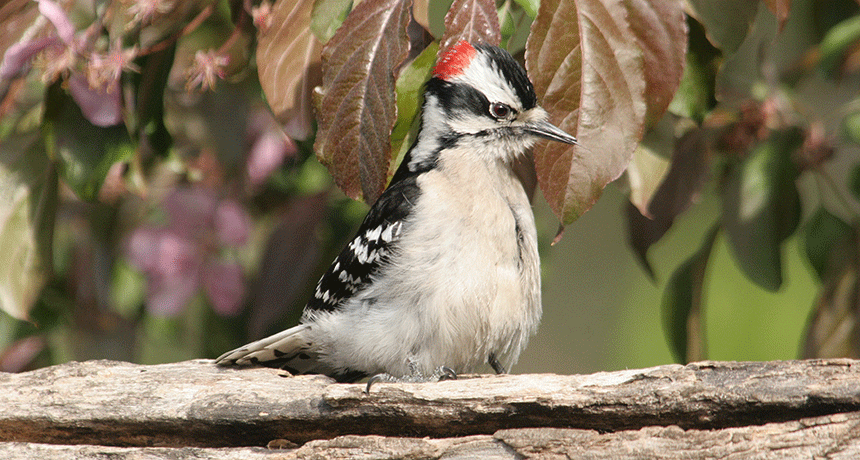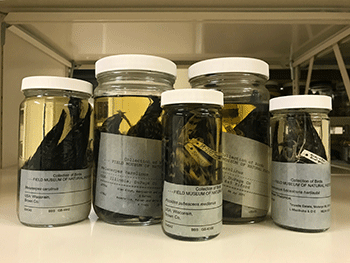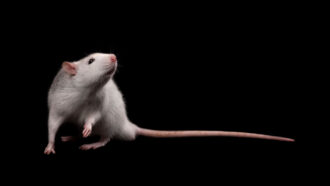Woodpecker brains host protein linked with human brain damage
Long-held belief that the birds don’t get concussions may not be true

Downy woodpeckers live in open woodlands across North America. Researchers estimate they peck some 53 million times over the course of an average 12-year lifespan.
Indiana Ivy Nature Photogapher/Flickr (CC BY 2.0)
Woodpeckers drill into trees to get lunch — a meal of insects that live inside the wood. The birds also peck to make holes deep enough for nesting. And when the birds peck, they peck hard. Very hard. They hammer their beaks into those trees so hard that their brains may get banged up. That’s the finding of a new study.
The study turned up a protein in the birds’ brains that in people would suggest the presence of brain damage.
This is surprising. A woodpecker’s brain experiences a force 14 times greater than what would cause a concussion in a human. A concussion is caused by a severe blow to the head. Scientists had long assumed woodpeckers are not harmed by that pecking. In fact, some sporting-goods companies have modeled their helmets after woodpecker skulls.
Severe or repeated concussions can cause brain damage in people. And one sign of that is the buildup in the human brain of a protein called tau. It can accumulate after a concussion. Alzheimer’s disease and other disorders that attack the brain also can lead to a buildup of tau.
While researchers have found tau in plenty of human brains, no one had ever looked for it — or other signs of brain injury — in woodpeckers, says George Farah. He is a biologist who studies the brain. “That’s what science is about,” he says — “questioning everything.”
Farah led the new study while he was a graduate student at Boston University in Massachusetts. His team’s findings appear February 2 in PLOS ONE.
Finding tau
In looking for data, Farah and his team turned to the collections of the Field Museum in Chicago, Ill., and the Harvard Museum of Natural History in Cambridge, Mass. The researchers looked at brains of 10 woodpeckers from five species. They also looked at brains from five red-winged blackbirds. Why blackbirds? Because they don’t peck, blackbirds served as a control (an unaffected comparison group). This let the researchers compare the brains of pecking and non-pecking birds.

All the birds had been preserved in jars of alcohol. The researchers removed the birds’ brains and took very thin slices. Each slice was less than a fifth the thickness of a sheet of paper. Farah and his team then stained the slices with a special dye that highlights tau protein.
Next, they looked at the brain tissue under a microscope. The stains turned up a lot tau protein in the woodpecker brains. Blackbird brains showed none.
Farah is careful to say his findings don’t prove that these woodpeckers had brain damage. Instead, they call into question that old assumption that these birds don’t suffer harm.
“Woodpeckers have been around for about 25 million years,” he notes. It doesn’t make sense for the pecking behavior to have lasted that long if the birds were seriously harming their brains with it.
Maybe their brains instead have evolved to handle tau protein, he says. Or perhaps, he says, tau protein might even protect a woodpecker’s brain.
Farah hopes this study leads other scientists to take a closer look at tau protein. “Maybe tau could be somehow useful or protective [of human brains],” he says.
Julian Bailes is a neurosurgeon and brain researcher at NorthShore University HealthSystem Neurological Institute. It’s in Evanston, Ill. A former doctor for the Pittsburgh Steelers football team, he has spoken widely about the risk of concussion among athletes. He agrees that people should be careful in interpreting Farah’s findings.
“Tau is very complex,” Bailes says. “The fact [Farah’s team] found it in the woodpeckers is very interesting. But we don’t even fully understand it in humans.” For instance, tau is not found only in damaged brains. It sometimes shows up in the brains of healthy people.
So it’s still too early to know how, or even if, the woodpecker data will help people. The best advice is still old advice, Bailes notes: When playing a sport where concussion is a risk, wear a helmet.







